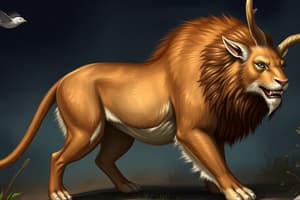Podcast
Questions and Answers
What is the CLASS Mammalia characterized by?
What is the CLASS Mammalia characterized by?
- Teeth
- Hair
- Endothermy
- All of the above (correct)
What defines the SUBCLASS Prototheria?
What defines the SUBCLASS Prototheria?
Extinct mammals
What does the SUBCLASS Theria include?
What does the SUBCLASS Theria include?
All living mammals today
What are INFRACLASS Ornithodelphia known for?
What are INFRACLASS Ornithodelphia known for?
What defines INFRACLASS Metatheria?
What defines INFRACLASS Metatheria?
What are Eutherians?
What are Eutherians?
List characteristics of ORDER Eulipotyphla.
List characteristics of ORDER Eulipotyphla.
What distinguishes ORDER Chiroptera?
What distinguishes ORDER Chiroptera?
What is ORDER Carnivora known for?
What is ORDER Carnivora known for?
What defines FAMILY Canidae?
What defines FAMILY Canidae?
What do members of FAMILY Felidae have?
What do members of FAMILY Felidae have?
What is FAMILY Ursidae commonly known as?
What is FAMILY Ursidae commonly known as?
What are animals in FAMILY Procyonidae known as?
What are animals in FAMILY Procyonidae known as?
Which animals belong to FAMILY Mustelidae?
Which animals belong to FAMILY Mustelidae?
What defines SUPERFAMILY Pinnipedia?
What defines SUPERFAMILY Pinnipedia?
What distinguishes ORDER Perissodactyla?
What distinguishes ORDER Perissodactyla?
What type of mammals belong to ORDER Artiodactyla?
What type of mammals belong to ORDER Artiodactyla?
What is unique about ORDER Cetacea?
What is unique about ORDER Cetacea?
What does SUPERORDER Xenarthra include?
What does SUPERORDER Xenarthra include?
What is distinctive about ORDER Cingulata?
What is distinctive about ORDER Cingulata?
What are the characteristics of ORDER Pilosa?
What are the characteristics of ORDER Pilosa?
What do members of ORDER Rodentia have?
What do members of ORDER Rodentia have?
What defines FAMILY Sciuridae?
What defines FAMILY Sciuridae?
What is distinctive about FAMILY Muridae?
What is distinctive about FAMILY Muridae?
What defines FAMILY Castoridae?
What defines FAMILY Castoridae?
What are FAMILY Hystricidae commonly known as?
What are FAMILY Hystricidae commonly known as?
What do mammals in FAMILY Hydrochaeridae include?
What do mammals in FAMILY Hydrochaeridae include?
What is ORDER PRIMATES known for?
What is ORDER PRIMATES known for?
What are the unique features of ORDER Lagomorpha?
What are the unique features of ORDER Lagomorpha?
What defines ORDER Sirenia?
What defines ORDER Sirenia?
What distinguishes ORDER Proboscidea?
What distinguishes ORDER Proboscidea?
Flashcards are hidden until you start studying
Study Notes
Mammal Classification Overview
- Mammals belong to the class Mammalia characterized by hair, teeth, endothermy, and viviparity.
Subclass Differentiation
- Prototheria: Represents extinct mammals with a simple level of complexity.
- Theria: Encompasses all living mammals today, divided into three infraclasses.
Infraclass Characteristics
- Ornithodelphia: Egg-laying mammals, known as monotremes, with only one living order.
- Metatheria: Includes marsupials, which are viviparous and possess pouches.
- Eutheria: Comprised of placental mammals that are viviparous, representing what is typically considered "normal" mammals.
Orders of Mammals
- Eulipotyphla: Primitive placental mammals, primarily insect-eaters, including shrews, hedgehogs, and moles.
- Chiroptera: Unique for being true flying mammals, with wings that are modified forelimbs (bats).
- Carnivora: Flesh-eating mammals including dogs, cats, bears, and weasels.
Families Within Orders
- Canidae (Dogs and Relatives): Long limbs, enhanced olfactory sense, and large ears.
- Felidae (Cats and Relatives): Notable for their facial structure characterized by rounded faces, large eyes, and ears.
- Ursidae (Bears and Relatives): Recognized by stocky legs, short tails, and forward-facing eyes.
- Procyonidae (Raccoons and Coatis): Medium to long tails with distinctive facial markings.
- Mustelidae (Weasels, Skunks, Otters, etc.): Often hunted for their distinctive fur.
Superfamily and Additional Orders
- Pinnipedia: Includes marine mammals with flipper-like limbs, such as seals and sea lions.
- Perissodactyla: Odd-toed hoofed mammals, with only 18 species, including horses and rhinos.
- Artiodactyla: Even-toed hoofed mammals, many being herbivorous ruminants, including cattle and deer.
- Cetacea: Aquatic mammals characterized by modified forelimbs and no hind limbs, including whales and dolphins.
Unique Superorders and Orders
- Xenarthra: Features mammals with skeletal adaptations and teeth that lack enamel, such as armadillos and sloths.
- Cingulata: Armadillos, characterized by armored plates and unique teeth structure.
- Pilosa: Comprising sloths and anteaters, recognized by their specialized limbs for climbing or digging.
- Rodentia: Known for their continuously growing incisors and diastema, providing adaptations for gnawing.
- Primates: Highly developed brains with a large cerebral cortex, showcasing arboreal adaptations.
- Lagomorpha: Similar to rodents with an additional set of incisors, comprising only herbivorous species like rabbits.
- Sirenia: Large aquatic mammals without hind limbs, forelimbs are adapted as flippers.
- Proboscidea: Features trunk-limbed mammals, recognized as the largest living terrestrial mammals.
Studying That Suits You
Use AI to generate personalized quizzes and flashcards to suit your learning preferences.




